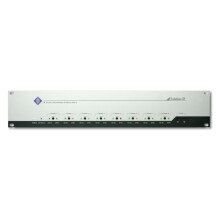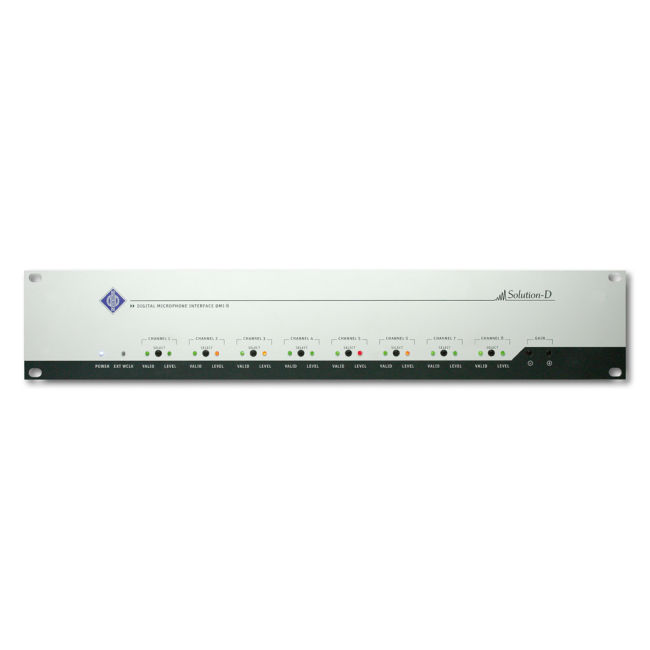« the future!! »
Published on 12/17/13 at 04:46digital converter dedicated to the range of digital microphones Neumann and Sennheiser
it comes in a rack for conversion (AES42 to AES EBU) and editing digital microphones
it is equipped with 8 digital AES 42 mono or stereo AES EBU shot, allowing the management and transport of a digital micro signal synchronously or asynchronously
there are two that come SUBD25 each active parallel signal to AES EBU standards (tascam, avid or yamaha) practice for splitter to front and back
I / O ext sync
I / O RJ45 to connect the computer via a format converter (RJ45 to USB) no possibility of wifi, because the connection is RS485
ADAT output
an option card allows connection to EtherSound network and the choice of the future for neumann go towards the "Ravenna" so soon with an optional card in this format
UTILIZATION
very simple, just connect the DMI8 to your computer via the connecting kit (RJ45/USB)
and connect your digital microphones Favorite in DMI8 via a 110 ohm AES cable.
then the RCS software is opened (remote control system)
which allows us to visualize and control the DSP Microphone
in this case Neumann (see photo below):
- The information on the micro (serial number, name, sample latency, hard and software version)
- Directivity control for multi pattern microphones
- Cut filter (160Hz and 40.80)
- Choice of sensitivity with 4 modes 0, -6, -12 and-18dB
- The gain between 0 and 63dB
- Mono or stereo microphone indication
- The test signal, to send from the dsp microphone signal (eg 1kHz) to the different users of micro (OB, front, back, etc. ..) very very clever!
- Clock, so it's managing the clock mode 1 asynchronous or synchronous mode 2
- A very sweet and digital compressor that can run full range or with a filter internal sidechain signal below 1, 2 or 4 kHz, making it work then as a de-esser.
- Then a peak limiter to adjust to the standard dBfs is yours.
and finally, all the control lights, sync level, comp, diode etc ...
GETTING STARTED
latency induced by the conversion, the work of the internal DSP microphone and transfers data to DMI8 is about a Sennheiser microphone MKH8000 22 samples / sec for fifty samples on Neumann 48kHz (either about a millisecond for Neumann and 0.4 milliseconds for MKH)
OVERALL OPINION
For my part, I am perfectly FAN of system because it offers a new way of sound,
the dynamics of these microphones is much more "analog" than scanned thereafter equivalent analog models. we gain neutrality, we lose the "microphone" Indeed, out of breath either, a timbral balance for some of these just exceptional pickups (I think particularly MKH8090 and KM185D) for these models the management of off-axis sounds, as can be seen in the schematic diagram of a polar KM185D is just bluffing,
DMI8 is the ideal interface to integrate your digital microphones on any other audio equipment, we would have liked more choice options (madi card, AES50 card or dante for example ....)
there are also few other products offering the same work, including RME DMC842 it allows the edition of the parameters from the front of the rack without being obliged to pass through the SCR (soft).
it comes in a rack for conversion (AES42 to AES EBU) and editing digital microphones
it is equipped with 8 digital AES 42 mono or stereo AES EBU shot, allowing the management and transport of a digital micro signal synchronously or asynchronously
there are two that come SUBD25 each active parallel signal to AES EBU standards (tascam, avid or yamaha) practice for splitter to front and back
I / O ext sync
I / O RJ45 to connect the computer via a format converter (RJ45 to USB) no possibility of wifi, because the connection is RS485
ADAT output
an option card allows connection to EtherSound network and the choice of the future for neumann go towards the "Ravenna" so soon with an optional card in this format
UTILIZATION
very simple, just connect the DMI8 to your computer via the connecting kit (RJ45/USB)
and connect your digital microphones Favorite in DMI8 via a 110 ohm AES cable.
then the RCS software is opened (remote control system)
which allows us to visualize and control the DSP Microphone
in this case Neumann (see photo below):
- The information on the micro (serial number, name, sample latency, hard and software version)
- Directivity control for multi pattern microphones
- Cut filter (160Hz and 40.80)
- Choice of sensitivity with 4 modes 0, -6, -12 and-18dB
- The gain between 0 and 63dB
- Mono or stereo microphone indication
- The test signal, to send from the dsp microphone signal (eg 1kHz) to the different users of micro (OB, front, back, etc. ..) very very clever!
- Clock, so it's managing the clock mode 1 asynchronous or synchronous mode 2
- A very sweet and digital compressor that can run full range or with a filter internal sidechain signal below 1, 2 or 4 kHz, making it work then as a de-esser.
- Then a peak limiter to adjust to the standard dBfs is yours.
and finally, all the control lights, sync level, comp, diode etc ...
GETTING STARTED
latency induced by the conversion, the work of the internal DSP microphone and transfers data to DMI8 is about a Sennheiser microphone MKH8000 22 samples / sec for fifty samples on Neumann 48kHz (either about a millisecond for Neumann and 0.4 milliseconds for MKH)
OVERALL OPINION
For my part, I am perfectly FAN of system because it offers a new way of sound,
the dynamics of these microphones is much more "analog" than scanned thereafter equivalent analog models. we gain neutrality, we lose the "microphone" Indeed, out of breath either, a timbral balance for some of these just exceptional pickups (I think particularly MKH8090 and KM185D) for these models the management of off-axis sounds, as can be seen in the schematic diagram of a polar KM185D is just bluffing,
DMI8 is the ideal interface to integrate your digital microphones on any other audio equipment, we would have liked more choice options (madi card, AES50 card or dante for example ....)
there are also few other products offering the same work, including RME DMC842 it allows the edition of the parameters from the front of the rack without being obliged to pass through the SCR (soft).



